With the upcoming Rastakhan’s Rumble expansion, new hand buff and deck buff cards will be added to Hearthstone yet again. These two mechanics have seen support over multiple expansions starting from the deck buff from The Mistcaller in The Grand Tournament and peaking in hand buff being the major mechanic of the entire Grimy Goons faction in Mean Streets of Gadgetzan.
However, both of these mechanics have largely failed. The Mistcaller never saw competitive play. Grimy Goons were the weakest of the three factions in Mean Streets. One could also argue that when these mechanics succeed – Prince Keleseth, anyone? – they are not a lot of fun. Yet, Blizzard seems to have a lot of faith in these mechanics, and they are iterating their design, looking for a way for them to be both successful and fun. Is it possible? What can we expect from hand buff and deck buff in Rastakhan’s Rumble? Let’s take a look at the history of each mechanic and what it takes for them to succeed.
Deck Buff – From Obscure to Dominant
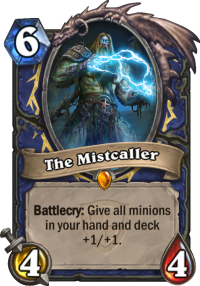
Deck buff, the ability to increase the health and attack of minions in your deck, is a potentially powerful effect. When minions have more attack and health than usual, the established wisdom falls apart. Flanking Strike does not kill a Happy Ghoul anymore. Saronite Chain Gang is suddenly able to take down all the minions from a Greater Emerald Spellstone. The potential value of buffing your deck is immense, but there are several caveats.
The first deck buff card, The Mistcaller, failed miserably. There were no decks that could make good use of it, and it waned away to history pages without much ado.
However, deck buff eventually became a successful, even dominant, mechanic in the form of one card, Prince Keleseth. This one card that even comes with a stringent deck-building restriction by denying any other two-drops from your deck is suddenly able to up your win rate by 10 percentage points or more. That’s insane!
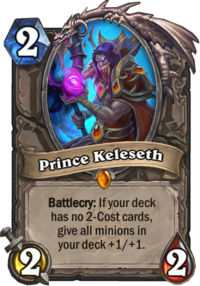
What is the difference between Mistcaller and Keleseth? Why did one fail miserably and the other build a lasting legacy?
Upon closer inspection of Prince Keleseth, it is interesting to note that the effectiveness of the card heavily depends on how early in the game it is played. Keleseth is most effective on turns one and two, boosting win rates by 10 percentage points or more. It is still moderately effective on turns three and four, boosting win rates in the neighborhood of 5 percentage points. However, starting from turn five, Keleseth’s effect on win rate becomes negligible.
There can be many reasons why this is the case. Keleseth decks are often aggressive, so the longer the game goes on, the less likely they may be to win overall. The effect of a +1/+1 buff is also more significant early in the game than late in the game – you are essentially playing minions worth one more mana than their cost when they are buffed and playing a four-mana minion on turn three is more impressive than playing a pair of five-mana minions on turn eight.
Deck construction also plays a part. In order to benefit from deck buffs, you want your deck to have a good number of minions – every spell you draw after the deck buff is just a regular card and not a supercharged version of itself. Some of the most common decks to run Keleseth are Zoolock, Deathrattle Hunter, and Spiteful Druid – decks that have a lot to gain from buffing their minions.
However, Keleseth has also found another niche in some control and combo decks that have nothing useful to do on turn two anyway: Shudderwock Shaman and Big Spell Mage. These decks make a very different use of the deck buff, not as a tool of aggression, but rather a tool that boosts their defenses and card draw. Saronite Chain Gang, Mind Control Tech, and Acolyte of Pain look very different with a Keleseth buff on them – they become good value for mana already stat-wise and have additional effects on top of that. Even here, an early Keleseth is much better than a late one: if you get to the late game, buffing up these minions no longer matters as much – it is the buff that helps you reach the late game.
Early aggression or early defense, the big impact is in the earlier stages of the game. Sure, sometimes your 9/9 The Lich King cannot be traded away by a mere 8/8 Mountain Giant, but there are lots of ways to do crazy swings in the late game anyway. Who cares about a +1/+1 buff when you can fill up your entire board with Dragoncaller Alanna or just win the game with Shudderwock?
This makes deck buff a difficult mechanic to balance. If it is readily accessible in the early game, it is dominant. If it comes into play later, it is insignificant. I’m not sure if it is even possible to strike a good balance with it.
Hand Buff – The Dream That Almost Was

Hand buff is an interesting mechanic that Blizzard has experimented with a lot, and that has found use in minor ways even though the decks fully dedicated to the mechanic were never able to find widespread success or see competitive play. Its success is less obviously linked to specific turns compared to deck buff and more related to specific card design.
Hand buff has been attempted in many forms:
- Buff to individual minions as battlecry (Don Han'Cho, Trogg Beastrager, Grimscale Chum), deathrattle (Shaky Zipgunner, Val'anyr), secret (Hidden Cache), attack (Brass Knuckles), end-of-turn effect (Grimy Gadgeteer), or spell (Soul Infusion)
- Buff to multiple minions as battlecry (Grimestreet Outfitter), end-of-turn effect (Grimestreet Enforcer), or spell (Smuggler's Run)
That’s a lot of different ways to buff minions in your hand, and there are many interesting observations to be made from all of these cards.
First, untargeted single-target buffs have largely failed. Don Han'Cho did not carry Grimy Goons to success, it hardly saw any play. It makes no difference whether the buff is a battlecry, a deathrattle, or what not, that type of mechanic is simply not strong enough.
Successful hand buff cards have at least one of the following three characteristics:
- Targetability: Grimscale Chum was successful, because it was a viable on-curve play that made your next play more powerful in an existing tribal deck. Other cards with pre-determined targets have failed when those targets have not been desirable or common enough – Murloc decks have enough Murlocs to practically guarantee a valid target, but Demon decks, for example, do not. Soul Infusion is successful, because it allows you a level of flexibility in choosing the specific target you want for it.
- Repeatability: Val'anyr is successful, because it is a pain to get rid of. Grimestreet Enforcer was moderately successful, because it had to be removed or it just stole the game. Grimy Gadgeteer, while not a mainstream success, was nonetheless the only Warrior hand buff card that had some success – you wanted to get rid of it before it made a giant Grommash Hellscream.
- Wide effect: The only class with a dedicated hand buff deck was Paladin thanks to Smuggler's Run, Grimestreet Outfitter, and Grimestreet Enforcer buffing the entire hand instead of a random minion and therefore providing much more value than a random individual buff.
While these characteristics determine which hand buff cards are desirable, their overall use also depends on the level of support the card pool provides for them. Let’s take a look at some good buff targets.
It is All for Nothing Without Support
While it’s all fine and good to recognize what makes specific deck buff or hand buff cards better than others, they also require a level of support from the rest of the deck – they need good targets.
The best deck buff and hand buff targets are minions that create copies of themselves when played:
- Saronite Chain Gang: Saronite Chain Gang is the ultimate support card. Two minions in one card and with Taunt as well. Great for offense, great for defense. Whenever you can buff this bad boy up, it’s gorgeous.
- Doubling Imp: Alongside Saronite Chain Gang, Doubling Imp is part of the reason Soul Infusion is good in Zoo right now. Having four minions that copy themselves when played is much better than having just two, although Soul Infusion can also be used to target other minions in the deck in various circumstances.
- Doppelgangster: Doppelgangster is only available in Wild nowadays, but it used to be one of the synergy cards in hand buff decks. Despite being able to create three minions with one card, it is not quite as powerful as Saronite Chain Gang, because the base stats of the individual minions are quite far behind the general power of individual minions on the board at its mana cost. Sure, getting 9/9 stats on the board for five mana after a single +1/+1 buff is great, but when it is in the form of three 3/3 bodies, they become much more susceptible to board clears or value trades. Given a choice between Saronite Chain Gang and Doppelgangster, I’d pick Saronite Chain Gang any day.
Other powerful buff targets include finishers – a big Charge minion can get a lot of work done – and minions with Divine Shield, as the buff makes them even worse to trade into. The Standard rotation will not happen yet, so there is still time to use Saronite Chain Gang in Standard, but it will be gone from that format in April 2019, which may weaken any deck buff and hand buff cards, unless it receives a worthy successor in the next two expansions. Keep an eye out for self-copying minions when evaluating these mechanics.
Revealed Deck Buff and Hand Buff Cards so Far
The initial Rastakhan’s Rumble reveal covered 16 cards, including cards for both mechanics as well as a potential support card. We already reviewed the entire batch of 16 cards, but now that we went more in-depth with these particular mechanics, what do the new cards related to them look like from this perspective?
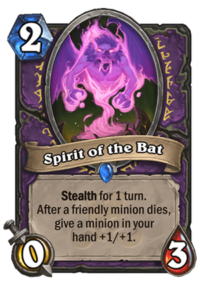
Spirit of the Bat is a hand buff card. Given our framework for evaluating hand buff cards, which boxes does it tick? The effect is completely random, so it does not fit the targetability criterion. It also buffs only one minion at a time, so it does not have a wide effect. The only criterion that kind of fits is repeatability, but even in that regard it has its upsides and downsides. If you have a wide token board, you can kill them off and get lots of hand buff ticks, but at the same time getting any ticks is completely dependent on getting minions to die. For current Warlock decks, this is a major problem, as they have not had expendable tokens ever since Imp-losion rotated out of Standard format. Spirit of the Bat would need a token generation engine to support it, otherwise it seems lackluster.
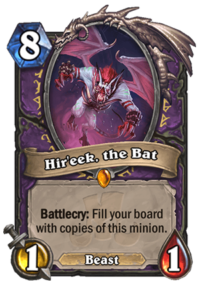
Hir'eek, the Bat is the companion card to Spirit of the Bat, and it kind of fits the bill. You can either get some buffs on it – difficult, as you cannot target those buffs – or you could play Hir’eek to create a board of tokens that will be sacrificed to buff up whatever else is in your hand. However, at eight mana, Hir’eek is prohibitively expensive for its intended purpose. Doppelgangster at five mana was already a borderline inclusion in hand buff decks, and while Hir’eek offers up to seven minions at once, the base stats are even lower. Hir’eek does not look like a savior of hand buff decks.
Surrender to Madness is the new deck buff card from Rastakhan’s Rumble. Three-mana spell, give all minions in your deck +2/+2, sounds good! Oh, but there is a downside, you destroy three of your mana crystals. Well, that’s a bummer.
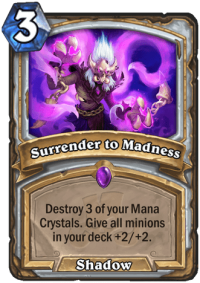
From past experience we know that deck buffs have been at their strongest when they are played early in the game and late-game deck buffs have seen no play. Losing three mana crystals means that you’re inflicting self-harm equivalent to playing against a Wild Growth + Nourish opener from a Druid. If you’ve played Hearthstone this year, you should know how it feels like to play with such a mana deficiency. Surrender to Madness is unplayable in the early game, and that is the key moment deck buffs need to be played to be effective. It is unlikely to be viable because of the discordance between when cards with such an effect are powerful and when it can be played.
We scored all three cards low in our initial review, and unfortunately the in-depth look does not reveal anything more promising about them.
In our interview with the game designers, Peter Whalen mentioned that there is at least one more unrevealed hand buff card in Rastakhan’s Rumble, so even if the initial reveals were not promising for the mechanic, there is still hope left.
What Would Good Hand Buff Support Look Like?
Evaluating the mechanics overall, it seems very difficult to get deck buff right. I hope Blizzard would abandon it altogether, because it changes from unplayable to dominant very quickly, which makes it a challenging mechanic to implement and balance.
Hand buff, on the other hand, is an interesting one. It briefly saw play in Handbuff Paladin as a core mechanic of the entire deck, one that was playable on ladder even if not quite competitive in tournaments. It continues to see play in a support role with Val'anyr and Soul Infusion. Blizzard has already experimented with several ways to implement the mechanic, and by focusing more on how to bring the right balance of targetability and repeatability to their hand buff cards, it could become a balanced and reasonable powerful mechanic.
These buffs need adequate support, and at the moment Saronite Chain Gang is miles ahead of any other support cards. Warlock has just enough support access with Doubling Imp helping out, but other classes are lackluster in that regard. The support could also take the form of tribal mechanics as showcased by Grimscale Chum, but that requires a well-established tribe – Void Analyst failed to see play for a reason, as there is no Demon core to build around right now.
With many more Rastakhan’s Rumble cards yet to be revealed, there is still hope for hand buffs in the next expansion. However, the initial reveals do not look promising and it looks like hand buff is unlikely to be competitive this year either. As a mechanic, it still shows promise, and maybe Blizzard will find the right balance for it at some point.


Wouldn’t Echoing Ooze also qualify as a target in Wild now (since you mentioned Doppelgangster)? … but the ooze has the added benefit that you can still buff it the turn you play it; Ooze > Mark of the Wild was a decent T4 play.
Yes, it does indeed, it is a great hand buff target!
I think Hir´eek will be part of some combo…because the card horribly sucks on it´s own…
Yeah ! Exaclty like Dr Morrigan had this awesome combo to make whoever opens her feel better
Basically it´s 400 dust…
I honestly cannot figure out what that combo would be. Eight mana is expensive, you need hand buffs or deck buffs to make it good, and it does not have Taunt either so aggressive decks can just try to kill you when you spend a turn to play it.
Excellent article (as always from authors of this site). I can only add – Emeriss.
Good point lmao
Carefully considered and very well-written…as always!